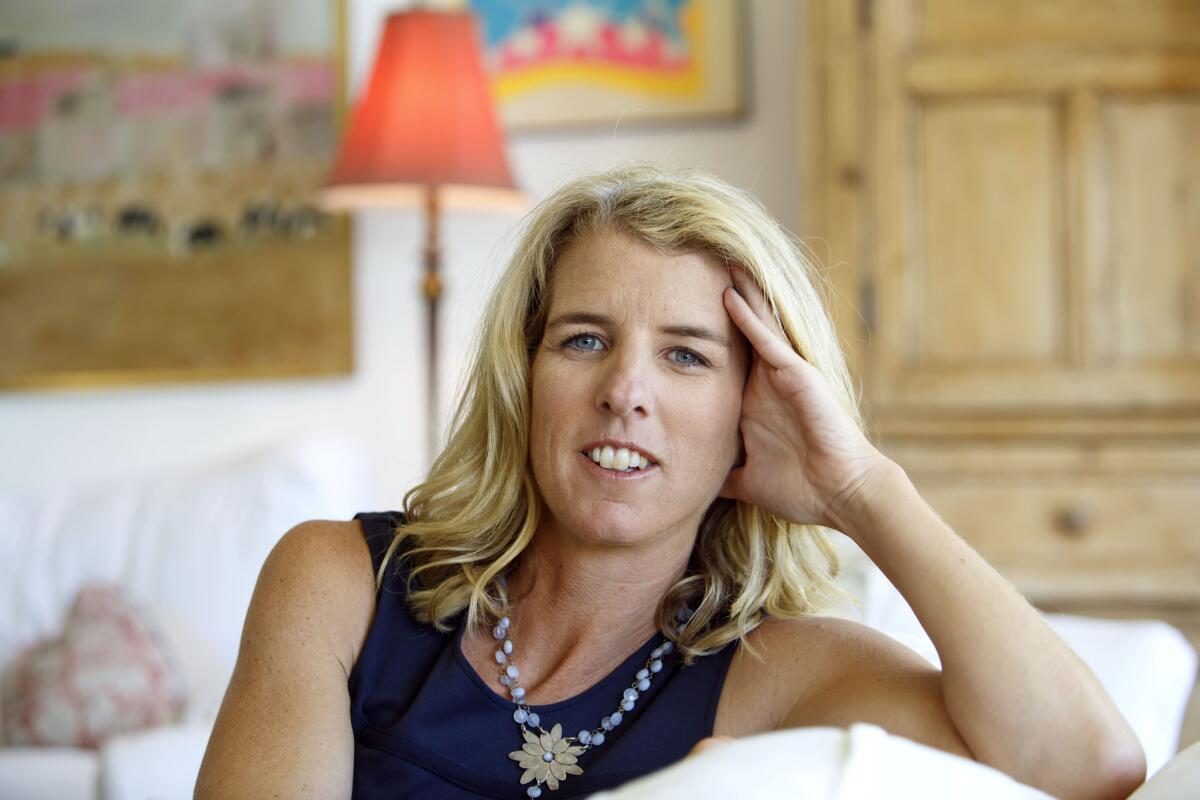Rory Kennedy recounts the 1975 fall of Saigon in new film

- Share via
Rory Kennedy thought she already knew something of the Vietnam War, of its tragedy and lingering scars on America and the Vietnamese. When she was approached about making a documentary on the final hours of U.S. involvement there, the director wondered whether the story hadn’t already been told many times over since 1975.
She had seen the news footage: the military choppers being pushed into the sea from the U.S. destroyer escort Kirk, the ships overloaded with desperate Vietnamese families, the long line of people leading to a rooftop helicopter evacuation.
“I felt like, ‘Hasn’t that already been excavated? Don’t we know this? Can I tell an original story here?’” she recalled thinking. “Then I did more research and realized there was so much I didn’t know about those last 24 hours.”
What Kennedy discovered was not more geopolitical minutiae for historians but dramatic stories on the ground as remaining American forces prepared to flee the capital of Saigon and the exodus of Vietnamese families fearing what would be left behind. Kennedy’s “Last Days in Vietnam” examines those final hours through personal accounts and previously unseen footage from the chaos of nearly 40 years ago.
Commissioned by PBS’ “American Experience,” the film debuted in January at the Sundance Film Festival and then opened last week at the Nuart Theatre in Los Angeles. It will go into wide release Sept. 26 and air on PBS in April.
“For me, the most exciting part of making this film is telling untold stories about Americans and Vietnamese who were on the ground, who went against U.S. policy and risked their lives to save Vietnamese,” says Kennedy, 45.
As a result of the Paris Peace Accords in 1973, a cease-fire had been declared and just 6,000 American noncombat troops and advisors remained in the country after more than a decade of fighting. Two years later, and after President Richard M. Nixon had resigned, North Vietnam rightly calculated that the U.S. wouldn’t act to stop an invasion that violated the treaty.
“We had elected a Congress at that point that was an antiwar Congress,” says Kennedy. “There had been so many protesters in the street, so many people had died, we had spent so much money, and people were just done.”
As the forces approached Saigon, American personnel prepared to leave. The plan for Vietnamese aligned with Americans was less clear.
To tell this story, Kennedy spoke with former U.S. military and Vietnamese nationals now in the U.S. to re-create those final days at the American Embassy and elsewhere. A startling scene unfolds aboard the Kirk, a magnet for South Vietnamese helicopter pilots fleeing with their families. The film includes dramatic and previously unseen Super-8 footage (shot by a Navy crew member) as the helicopters, low on fuel, hovered overhead.
“It was very emotional,” Stuart Herrington says of watching the documentary. He was a U.S. Army captain who helped lead an unsanctioned operation to transport Vietnamese to an American air base, then onto American ships bound for the Philippines. “She took the sad and tragic events of the fall of Vietnam and managed to illuminate a series of uplifting events. I was very surprised and deeply moved.”
Then-U.S. Secretary of State Henry Kissinger offers a perspective from the Oval Office of newly installed President Gerald R. Ford, and Kennedy recounts real dread on the streets of Saigon through interviews with survivors of the evacuation, including Frank Snepp, a CIA analyst on duty at the Embassy. There is no commentary from historians or others who were not on the scene.
“There is something nice about having a documentary that is a document,” says Kennedy. “There’s nobody telling you what to think. There’s no Republican or Democratic ideology. There’s no blaming one particular group of people. There’s just looking at the situation and having insights into it from people who were there and memories of what happened.”
A key figure in the narrative is Graham Martin, the U.S. ambassador, whose own son had been killed during what was then America’s longest war. As North Vietnamese forces got closer to Saigon, Martin chose to delay any action on evacuating locals from the country. American military personnel risked court-martial by defying that decision.
“By the month of April, you’d have to be brain dead not to know what was about to happen,” says Harrington. “The only one who didn’t seem to understand that the North Vietnamese were about to conquer the country was the ambassador. He had a very determined goal of not letting South Vietnam go under at the point of an AK-47.”
At the very end, as recalled in “Last Days in Vietnam,” Martin delayed his own exit from the Embassy to allow more Vietnamese to escape. Harrington calls him “a tragic figure,” and Kennedy was determined to depict his role with all its complications.
“I think he had good intentions and made a lot of bad decisions along the way,” Kennedy says. “It was a challenge to capture that nuance, because I really didn’t want to simplify him or for it to be a reductive portrait.”
Four decades later, as the U.S. finds itself entangled in a fight with the militant group Islamic State in Iraq and Syria, the lessons of the fall of Saigon could not be more relevant.
“There are some real parallels to what our story focuses on,” says Kennedy, “which is, How do you get out of a war? Should we go into Syria? How did we go into Iraq? What is the process of getting out of Iraq and Afghanistan? We’ve been working through those questions, and I think understanding what happened in Vietnam offers some answers and insights.”
Her 97-minute film is focused on one small, heart-wrenching chapter in the tragic story of the Vietnam War. Kennedy notes that Ken Burns is now at work on a multichapter history of the long conflict (for a 2016 broadcast).
“It’s really important in my approach to documentary filmmaking to kind of pick and stick and to keep the story contained,” she says. “You are constantly being pulled in a million different directions to unpack different ideas and go down different paths.”
Her first documentary was 1994’s “Women of Substance,” which grew out of a student paper she wrote at Brown University on female addicts whose personal stories were starkly different from what she’d seen in the media. Kennedy hadn’t studied filmmaking but realized its special ability to communicate what she’d discovered.
Kennedy already admired the work of filmmaker Barbara Koppel, known for the Oscar-winning “Harlan County, U.S.A.,” and was intrigued by the cinéma vérité of groundbreaking documentarians Richard Leacock and D.A. Pennebaker. Likewise, none of Kennedy’s films was remotely autobiographical, with one major exception: 2012’s “Ethel,” which told the story of her mother, the widow of her father, Robert F. Kennedy, and which was her first to examine her famous family. “And last,” she says with a laugh.
The project came at the insistence of Sheila Nevins, president of HBO Documentary Films and a major force in the genre. Kennedy’s mother also surprised her by agreeing to participate.
“I’m really glad I did it, but it was very hard,” says Kennedy, who lives in Malibu. “All my life, I’ve been taught to look outside of myself and into the world and the challenges that people face. So it was uncomfortable, and it was uncomfortable for my mother and all of my siblings, to talk about ourselves.”
Kennedy hasn’t announced her next project, but she calls this “a really exciting time for documentaries,” with new avenues for audiences to easily locate nonfiction films online, on-demand and in theaters.
“We’re up against the marketing machines of Hollywood, which have much bigger budgets, so we’re still challenged in many ways in letting audiences know about our films,” she says. “But audiences have been exposed to some really extraordinary stories, and they’re genuinely interested in getting more.”
More to Read
Only good movies
Get the Indie Focus newsletter, Mark Olsen's weekly guide to the world of cinema.
You may occasionally receive promotional content from the Los Angeles Times.











